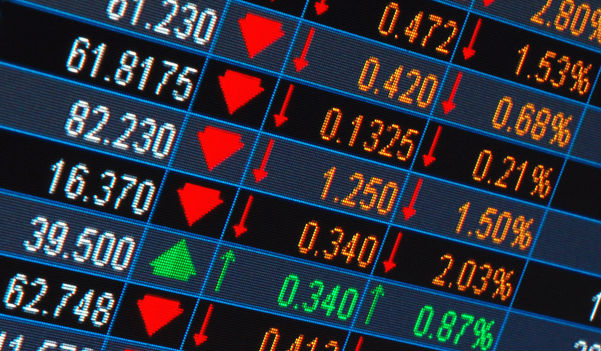Recession looms as economy falters
June 6, 2022
“It’s a reset, it will happen,” said Mr. Hanson, an electives teacher, about the possibility of a recession.
Hanson is basically saying that the economy will go into a tailspin to reset itself after years and years of growth.
It had been nearly half an hour since the start of our discussion. As I sat in Mr. Hanson’s room, a repurposed computer lab filled with various paraphernalia to be used as props in his Entrepreneurship and Marketing classes, our discussion meandered from the economy’s future to the past recessions and crises. It may have veered off course, or have gotten sidetracked, but it came to the same three ideas: where the economy is, how it got there, and where it may go.
The Background
Like so many things, Covid turned the economy upside down. To understand, we need to go back to March 2020.
You look around the country and see panic. There’s this new virus going around, cases are going up, people are panicking. Stores and businesses are shuttering their windows and closing their doors. The impossible has happened — a new pandemic.
People don’t know what to do. The rug’s been pulled out from under their feet. Millions of people are unemployed or had their hours cut. The country’s going into lockdown for who knows how long.
In comes the government. The country’s panicking, someone’s shouted the proverbial fire in the movie theater. There’s no time for finesse, the people need security and they need it now. In comes the CARES Act of March 2020.
It came in at a whopping $2.2 trillion. Amongst its plethora of actions a few notable strategies stand out: direct payments to Americans, increased unemployment benefits, tax breaks, and small business loans. Relief had arrived. Americans took comfort that the government wasn’t sitting idly on the side — they had security.
Yet it didn’t stop there. Over the next year, an additional $3.3 trillion was spent on other policies; the most prominent being the Consolidated Appropriations Act at $920 billion (which provided stimulus checks), and the American Rescue Plan at $1.9 trillion.
All in all, from March 2020 to March 2021, well over $5 trillion was printed. As of 2019, the U.S. GDP (Gross Domestic Product), a simple way to measure economic activity and power, was $21.73 trillion. In one year, a quarter of the country’s GDP was printed and distributed.
As so often the cases when something becomes more common, its value drops. In this case, it was the dollar, which contributes to the inflation we see today.
However, it gets even better. Since the start of Covid we’ve experienced or are still experiencing lock-downs, rampant inflation, supply chain issues and bottlenecks, war, increasing prices of oil, and numerous other crises.
I’ll take these issues one at a time. First, inflation. Shockingly, the United States is experiencing the highest inflation seen in nearly 40 years, since the time of stagflation. The annual inflation rate over the past year is 8.3% according to CNBC. Everything costs more. People are hurting. They now have to make decisions on where they can save money and what they have to cut. They’re encouraged to save and tighten their belts. Frankly, there’s significant pressure on the economy to slow spending.
Next is supply chain issues. I’m sure you’ve heard of it, but it’s still happening. Companies and consumers often find their orders delayed or unable to be fulfilled due to supply shortages. In accordance with the all-powerful law of supply and demand, when demand rises and the supply shrinks, prices go up. Companies still need to sell their goods, so they cough up the cash and pass on the costs to consumers who find that their purchases are more expensive.
These supply chain issues have only been exacerbated by the recent Chinese lockdowns. For weeks, the world’s second-largest economy has been under the most severe lockdowns since 2020. Amongst the places most affected by these lockdowns is Shanghai, the world’s largest container port.
It’s no secret that China is the world’s factory; they produce a significant portion of the world’s goods. So, when its largest city shuts down to the point where trucks couldn’t even enter or exit to transport cargo — that’s a problem. Companies didn’t know when their orders would arrive. Faced with the possibility of waiting weeks, or even months for crucial components, they raised their prices once again on whatever they could still sell.
Ukraine. You and I both know what it means. It’s been nearly one hundred days since the start of Russia’s invasion. In that time, we’ve seen Russia leap past Iran and North Korea as the most sanctioned economy in the world. Multiple rounds of sanctions have been placed on Russia, and most recently, the European Union has agreed to ban Russian oil. It will immediately ban 75% of oil, and 90% by the end of the year according to CNBC.
That has big consequences. The EU needs to find a new source of oil fast. Once again, supply and demand comes into the equation and the price of oil rises. In addition to oil, the price of natural gas has risen as well because the EU is trying to wean itself off its dependence on Russia.
That rise has caused the ever-growing bill at the pumps. Not just for you or me, but everyone. Oil is used in every step of the supply chain in one way or another; whether from the production of plastics, to oil derivatives, to fueling tractor-trailers, nothing is out of its reach. These increased costs are then passed onto the consumer making their purchases even more expensive and encouraging them to drive less.
However, that’s not even all the havoc Russia has caused. Between the sanctions and the war, nearly all exports from Russia and Ukraine have been halted. Russia is a major producer of metals, oil, natural gas, fertilizer, and staple grains. Ukraine is a major exporter of staple grains and seeds, minerals, and neon gas.
Grain doesn’t need much of an explanation. According to CNBC, Ukraine and Russia produce a quarter of the world’s wheat, much of it being exported to the Middle East and Northern Africa. Much of their grain is unable to be exported, leaving those regions vulnerable to food shortages. In addition to staples, Russia is a major supplier of fertilizer, which only worsens the food crisis. The shortage of food worsens inflation in the at-risk countries and leaves them unstable, hurting the global economy.
Unsurprisingly, Russia and Ukraine export resources that are desperately needed to produce advanced technology, namely nickel, and neon gas. Nickel is a key component of electric vehicle batteries. The sanctions have worried the market, causing nickel’s price to rise. In fact, at one point, it was selling for over $100,000 per metric tonne according to CNBC, which resulted in the suspension of trading for the day.
Neon is an essential component in the manufacturing of advanced semiconductor chips (which are used in almost any product). Before the war, according to CNBC, Ukraine manufactured more than half of the world’s neon supply for chips. Now, their production for the year is unknown, but presumed to be far lower than last year. Chips are already in short supply, with car companies having to pick and choose what models they can and can’t make. The short supply of chips is currently one of the major supply chain issues that the world is experiencing — that’s without a neon shortage.
That was a lot, so I’ll do a quick summary. Most of the problems started with Covid and the overprinting of money which led to the devaluation of the dollar, which started inflation. It was then worsened by other problems like supply chain issues, the war in Ukraine, high energy prices, and lockdowns. They all contributed to inflation and what we’re seeing today.
Whew! That was a hard pill to swallow, but now the worst of it is over. We’re at the present with an understanding of what’s led to the point we are at.
Our Status
Recession. It’s a scary word, but we need to face it, that’s where we’re at. Or, at least, that’s where Mr. Hanson thinks we’re at.

He’s lived through six economic downturns and has worked in a variety of industries. He’s worked for twenty-five years in retail management with ten of those years as a regional manager at blockbuster-type stores. Then, he got a dual license in history and business, and after teaching history for a few years, came to Ludlow High School.
The thing is, he’s not the only one who thinks we’re going to experience a recession. George Costa, a civil engineer of twenty-five years, believes much the same. He’s worked in Springfield, Boston, New York City, and most recently, is a self-employed business owner.
Both of them are looking at inflation and the devaluation of the dollar as signals that a recession is coming.
Hanson believes that a recession “in the next 10-12 months will happen,” citing inflation, claiming that “It hasn’t been this bad in 40 years, since I was in high school.”
Michael Costa, a junior at Ludlow High School, agrees as well, saying a recession is “more likely than not,” pointing to the year-to-date value of the Dow Jones Industrial Average (a collection of the thirty most prominent stocks on the market).
The value of the Dow Jones is down by 12.2% from the start of the year.
Hanson says that “[inflation’s] so close to the heart” and that he just finished teaching it to his classes the previous week because he uses current events in his lessons.
Hanson says that “the American Rescue Plan just killed us,” a claim Costa agrees with, commenting that “[the government] needs to stop giving money out” so the value of the dollar doesn’t depreciate more.
Currently, while Hanson believes that a recession may occur, it isn’t inevitable. According to him, “when unemployment starts going up, then we’re in trouble.” Furthermore, he says “gas has a lot to do with recession,” and that its price will continue to rise.
That’s something Costa is all too familiar with.
Costa, as a civil engineer, works in an “elastic” industry. It’s when the industry grows and shrinks with the economy — it grows during good times and shrinks during the bad.
As a civil engineer, he works closely with construction companies to create designs and blueprints, and as a result, is familiar with how the industry works. He claims that he knows a contractor who is “spending $52,000 a month in additional fuel costs,” which comes out of the contractor’s pockets.
Both Costa and Hanson agree there is one entity that can stop a recession: the Fed. The Federal Reserve controls benchmark interest rates (the lowest interest rates a bank can administer on a loan) and influences lending.
Hanson says that “It’s been a runaway train for the last couple of years because interest rates have been so low.” He believes that a recession would be “up to the Fed” and that it must act or face a recession.
Costa has similar opinions as a result of his profession.
Thanks to his proximity to construction companies, he believes that “just about every project is financed with loans” and that “nothing is paid in full.” He says that those loans “are mortgages in a sense.” and can often last for twenty to thirty years.
With higher interest rates, he believes that companies would be disincentivized to take out loans, which would help slow down the economy and tame inflation.
When asked if they believe recessions are evil, they both said “no,” and likened a recession to a “reset.”
Wrap Up
Right now, no one knows which way the economy will go. Everyone has their own opinion, but only the Fed will determine what will happen.
A recession could happen, and if it does, the town would suffer. The school income would shrink, companies would slow down, and there would be fewer opportunities.
However, the only way to tell is to keep informed and watch the market.


